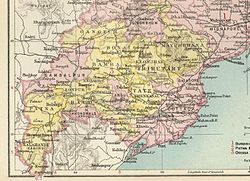Mayurbhanj State
| Mayurbhanj State ମୟୁରଭଞ୍ଜ ରାଜ୍ୟ |
||||||
| Princely State of British India | ||||||
|
||||||
|
||||||
| Mayurbhanj State in a 1901 map of the Imperial Gazetteer of India. | ||||||
| History | ||||||
| • | Established | Late 17th century | ||||
| • | Accession to the Union of India | 1949 | ||||
| Area | ||||||
| • | 1901 | 10,982 km2(4,240 sq mi) | ||||
| Population | ||||||
| • | 1901 | 610,383 | ||||
| Density | 55.6 /km2 (144 /sq mi) | |||||
| Today part of | Odisha, India | |||||
Mayurbhanj State (Odia: ମୟୁରଭଞ୍ଜ ରାଜ୍ୟ) was one of the princely states of India during the period of the British Raj. It was one of the largest states of the Eastern States Agency and one of the three states of the Bengal States Agency. The emblem of the state were two peacocks for according to legend the ancestors of the ancient rulers originated from a peafowl's eyes.
The state included a vast mountainous area inhabited by many different people groups such as the Santal, Ho and Kisan people. Its former territory lies in the present-day state of Odisha, bordering West Bengal. The capital of the state was the town of Baripada since the 15th century and Daspur was another important town. Large tracts of Mayurbhanj State were covered with forest.
According to tradition the kings of Khijjinga Mandala, the predecessor state, had ruled in unbroken succession since about the 9th century AD. The state had been named after its capital, Khijjinga Kotta, today Khiching. Copper plate inscriptions issued by the ancient rulers indicate that Khijjinga Mandala was an extensive territory comprising the present Mayurbhanj and Kendujhar districts as well as parts of Singhbhum district in Bihar and Midnapore district in West Bengal. During the Mughal period, the territory of the Bhanja rulers extended as far as the Bay of Bengal. By that time, the capital had shifted from Khijjinga Kotta to [Mayurbhanj district|Haripur]]. The ruins of the temples and palaces built then can be found at Haripur about 16 km southeast of Baripada. Among the ruins, the Rasikaraya temple and the Durbar hall of the Bhanj kings are the most significant.
...
Wikipedia



